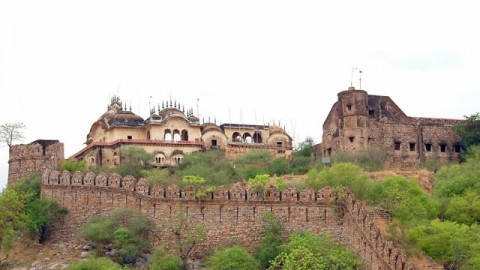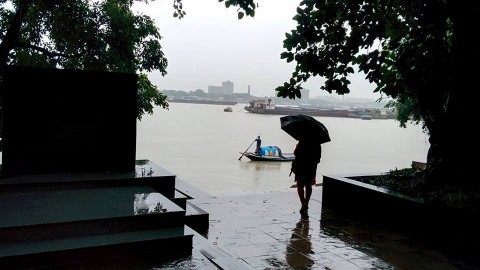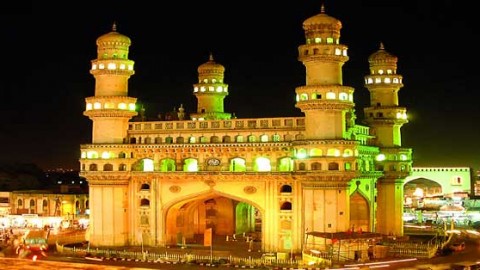An amazing juxtaposition of majestic medieval age and modern industrialization, mainly the Hydro Electric Plant on the Chambal River and the Nuclear Power Plant. It has a few traces of its past still left. The fort overlooking the river Chambal is the foremost tourist attraction. It also houses the museum with a rich collection of art and artefacts and some elaborately painted chambers.

Image Courtesy: kotadekho.com
Earlier it was a part of Bundi State, but later it grew into an independent and bigger State. What retains the past glory are the untouched wealth of impressive forts, opulent palaces and temples dating back to over several centuries. These temples were conquered by the Hada chieftain Rao Deva. It was at the time of the Mughal Emperor Jahangir that Rao Ratan Singh gifted this territory to his son Madho Singh. The Kota State is reflected in the form of a beautiful collection of Stone Idols (murties) in the Raj Mahal, embellished with gold stained glass work on the walls, silver mirror work on ceilings and marvellous wall paintings.
Besides the Akh-ka-Mahal REGALIA shows paraphernalia and the State. Then there is the Badal Mahal (privacy quarter) in Kota models flaunting their beauty. The paintings of the schools in different periods are fixed at the glass walls, the ladies in the eco interactions Zanan Mahal is worth a look.

Other buildings of the bygone era are represented in Brij Raj Bhawan Palace, Jaguar Mandir, a palace on the island and a magnificent Haveli (mansion) with beautiful frescos and royal cenotaphs. Kota is now well known for its famous dams and Kota Doria saris, woven in the nearby village Kaithoon. These are made of cotton and silk in an assortment of colors, and delicate gold thread. Miniature paintings of hunting scenes depicting the forest that attracted many of the aristocracy and royalty to engage with passion in this sport wild calling Kota, magic along the Chambal River.
Climate:
Summer: max. 43.0 °C min. 35.0 °C
Winter : Max. 30.7 °C min. 5.0 °C
Rainfall : 75 cms.
Access:
Air : The nearest airport is Jaipur.
Train : The Railway Station is located about 2km south of old city. There are rail connections between Bundi and Chittaurgarh.
Road : There are Express buses heading for multiple destinations in Rajasthan like Ajmer, Bijolia, Bikaner, Chittaurgarh, Jaipur, Jodhpur, Kota, Sawai Madhopur and Udaipur.

Kota Dussehra Festival:
Dussehra is celebrated in Kota in September-October this festival is celebrated all over the country but the Kota Dussehra is quite unique for it is more than just the beginning of a festive period.
More than 75 feet tall effigies of the demons Ravana, Kumbhakarana and Meghnad are burnt on Dussehra day to symbolise the victory of good over evil. Usually these effigies are filled with crackers. A young child dressed as Lord Ram is made to shoot an arrow of fire at Ravana and the huge figure is burnt.
Villagers gather here dressed in multicolored clothes to offer prayers to Lord Rama and to celebrate his victory over Ravana. Prominent artistes from all over the country are invited to participate in cultural programmes that enthrall the huge audience with their performances.
Rich in courtly splendour and age old traditions, the Dussehra festival here is marked by a glittering procession which attracts thousands from the surrounding villages. Like all festivals in Rajasthan, it provides a good opportunity to the traders to display their attractive wares to the rural and urban buyers. Small effigies of Lord Ram, Sita and Lakhsman are very common works of sculpture. The fair lasts for about a fortnight.
Sight Seeing:
SUKH MAHAL
Sukh Mahals evoke memories of Rudyard Kipling who not only stayed here but found inspiration for his famous work ‘Kim’.
KSHAR BAG & CHRISTIAN GRAVEYARD
Kshar Bag is situated close to Chhatra Vilas Garden and has the cenotaphs of the former rulers of Kota.
Close to the Nayapura Circle is the graveyard of British soldiers who were killed during the uprising of 1857 AD.

Photo: thesuryahotels.com
GARH PALACE
The foremost tourist attraction in Kota is the ‘Garh’. This large complex,
also called the City Palace is built in a predominantly Rajput style of architecture. The palace is a rambling complex of suites and apartments built by different rulers at different times.
RAO MADHO SINGH MUSEUM
Situated in the old palace, it houses a splendid collection of Rajput miniature paintings of the Kota school, fascinating sculptures, arms and valuable antiques.
MATHURADHISH TEMPLE
This is the most important seat of Vallabhacharya sect of the devotees of Lord Krishna. In the 18th century, the then ruler of Kota, Durjanshal brought the image of Lord Krishna from Bundi. Seated in the heart of the city, the Lord bestows his blessings on the masses.

Photo: thesuryahotels.com
ABHEDA MAHAL & KARANI MATA TEMPLE
Situated about 8 kms. from Kota on the bank of a tank. This medieval palace was the recreation spot of the rulers of Kota, where they went to enjoy watching the wildlife and natural beauty. Close to Abheda Mahal is Karni Mata Temple, the reigning deity of Kota.
DAD DEVI TEMPLE
It is situated about 18 kms from Kota. The temple deity of the royal household of Kota is surrounded by thick forests and is an ideal place to spend some quiet moments.
CHARAN CHAUKI
On the way to Dad Devi, 15 kms from Kota City, Charan Chauki marks the legendary spot where Lord Krishna is said to have rested for a brief while travelling to Dwarka from Mathura. The footprints of the Lord have been preserved here.
SAFARI ON CHAMBAL RIVER
Gods have been very kind to the City of Kota. They have blessed it with life giving water of Chambal River and lots of bright sunshine. Chambal River runs through deep gorges and high rise mud walls, gurgling falls and pebbled ruffles. Its turquoise blue water provides sustenance to jade green forests and bountiful crops.

Image Courtesy: wikipedia.org
PHOOL SAGAR
The Phool Sagar is an excellent and well-planned structure as also the decoration of this Rajput edifice. The same beauty and its excellence lies in the massive Taragarh fort. This little town has not yet lost a medieval grandeur. Bundi is not exactly a tourist tramping ground but nevertheless, this adds on to its appeal with a curiosity to explore it. The look of the town has a bluish hue similar to that of Jodhpur. The original history claims that Bundi was once the capital of the great Hadoti Kingdom. However Kota, in 1624, was separated and became an independent State.This marked the beginning of downfall of Bundi.
The exquisite beauty of its surroundings, its isolation from the madding crowd, its rivulets, hills and valleys, lush green fields, its charm during rainy season, rich variety of flora and fauna, magnificent palatial structures, its winding ways and above all, the simplicity of the rural folk lend the city of Bundi a uniqueness that hardly any place of tourist attraction in the state can claim. It was basically for this reason that Rudyard kipling was mesmerized by its beauty which he captured and expressed in this literary works.

Photo: ranglaindia.com
TARAGARH FORT
It was built in 1345 and is great to ramble around at leisure. This is rather a ramshackle fort, with its overgrown vegetation.
The view over the town and surrounding countryside from the top are magical, especially at sun set. Inside the ramparts are huge reservoirs carved out of solid rock, and the Bhim Burj, the largest of the battle-fields, on which there is a famous cannon. Taragarh is reached by steep road leading up the hillside to its enormous gateway. Take a path up behind the Chitra Shala; go east along the inside of the ramparts then left up the steep stone ramp just before the Dudha Mahal, a small disused building 200m from the palace.
Near Kota:
Bundi
Bundi is a magnificent town, 36 Kms from Kota, once ruled by the Hada Chauhans. First destination is Hadoti set in a narrow inclining gorge. The palaces and forts have a fairy tale quality about them. Isolated and independent, this picturesque location has much to offer. Rajput architecture shines in the intricately carved brackets and pillars. Interesting places are Diwan-e-aam, Hathia Pol, and Naubat Khana.

Photo: Suryahotels.com
The paintings of Bundi School are famous for their festivals, animals and bird scenes portrayed beautifully.
During the State time, Bundi was popular for hunting. Equally popular were the hunting lodges like Phool Sagar Palace, Sukh Mahal and Shikar Burj.
Jhalawar
The princely State of the Jhalawar was created in 1838 AD, after being separated from Kota by the British. It is best explored by foot within the city and a horse safari in the outskirts, as Jhalawar boasts of rich natural wealth, with vibrant flora and fauna.
Since it is situated at the edge of the Malwa Plateau, it has a rocky but water-laden verdant landscape unlike much of Rajasthan. Jhalawar is known for its exquisite pre-historic cave paintings, massive forts, thick woody forests, exotic wild life and a lush country side which has red poppy fields and orange-laden orchards. Small wonder then that the city looks fascinating and colourful during winters.

Photo: twitsnaps.com
The massive fort Garh Palace is located in the centre of the city. We find exquisite paintings on the walls and mirrors. The museum has a collection of rare manuscripts and sculptures. Bhawani Natya Shala is one of the few theaters in the region, built in 1921. Just 12 Kms. away from Jhalawar, you can find an impenetrable fortress Fort Gagron surrounded on three sides by rivers as an example of “Jal Durga”. The 7th century old rock cut caves and Buddhists Kolvi and Vinayka (90 kms.) are also worth a visit.
The main attractions are the periphery Jhalrapatan (City of Bells), with a huge Surya temple of the 10th century that has beautiful carvings and beautifully preserved idol of the “Surya” at the rear. Inside the temple, it is an idol of Vishnu erected in the 11st century. The Lord Shantinath Jain temple is located in the centre of the city. A little far is the Chandrabhaga temple with a garden. Furthermore, Herbal Garden, Dwarkadhish temple, Naulakha in Fort Jhalrapatan and Dalhanpur (54 kms), Ren Basera (5 kms), Mau Borda Palaces (25 km) are the other places of tourist interest.
Transportation:
Autorickshaws, tongas and bicycles are the best mode of transportation.
Shopping:
In main Bazaar, cotton carpets of Nainwais, famous Kota miniature paintings and Kota doria saries of Kota, stone statue art, wooden toys of Jhalawar and lac bangles are what one can shop.









